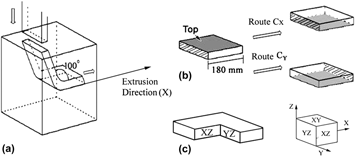Article contents
Study on structure homogeneity of plate sample with large dimension during equal channel angular pressing (ECAP)
Published online by Cambridge University Press: 20 October 2016
Abstract

A self-made die with large cross section (180.2 × 22.2 mm) for equal channel angular pressing (ECAP) was used to study the influence of two different pressing routes (C X and C Y ) on refining homogeneity of high-purity aluminum plates. Microstructures were investigated by optical microscopy (OM) and electron back scatter diffraction (EBSD) methods, and micro-hardness and tensile tests were taken to evaluate deformation degree across the cross section and mechanical properties, respectively. The results indicate that pressing routes of ECAP have a great influence on structure homogeneity of plate samples. The route C Y leads to fine grains with better homogeneity because the same deformation direction is taken through each pass. Coarse columnar crystals with 3–4 mm change to 68.6 μm nearly equiaxed grains and a strong cube texture forms after four C Y passes, and corresponding mechanical properties increase by a factor compared to as-cast plate.
- Type
- Articles
- Information
- Copyright
- Copyright © Materials Research Society 2016
Footnotes
Contributing Editor: Jürgen Eckert
References
REFERENCES
- 8
- Cited by





